Liriope makes me dream
Friday, 29 July 2022

Wow. We had some rain come through 5ish and it cooled things off…to a mere 79°F now. Take me back to the equator, please! [Where it’s cooler, at least on the water.]
Friday, 29 July 2022

Wow. We had some rain come through 5ish and it cooled things off…to a mere 79°F now. Take me back to the equator, please! [Where it’s cooler, at least on the water.]
Saturday, 23 July 2022

Not long after we got on the (major, national) divided highway this morning, we came upon a construction zone, and got shunted over this side route leaving both travel lanes to the repaving crew.
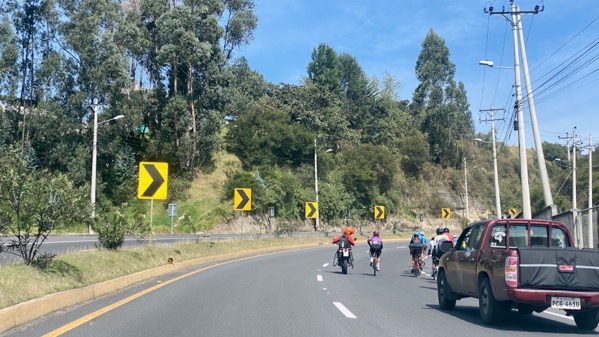
During this morning’s jaunt, we came across several groups of bicyclists, leading us to conclude that Saturday is for bicycle outings and practices.

We also found this wide load (carga ancha). Not sure what it was, but it looked rather like a reviewing stand, with many streamers.

Just off the highway, we made our turn at this church to take a very local road to the parking area for hiking in the Pasochoa cloud forest, officially Refugio de Vida Silvestre Pasochoa.

For all but perhaps fifty meters of the 5.3 km access road, we bumped along at a very slow speed. Many pickups passed us, despite this being such a narrow, one-and-a-bit lane road.

The land use change is the edge of the park, with farmers pasturing animals right up to the forest.

Here’s the map of the hiking trails, aka senderos. We opted for the medium-length middle one.

The path was okay, not muddy thankfully.
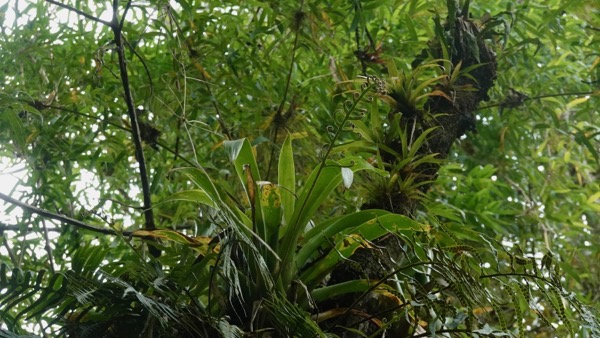
We immediately found bromeliads.

The path was in the selva (jungle), but just in it along the edge of a field. I suspect some of the plants we saw were introduced from agricultural undertakings. Not sure about this, but clover seemed like it was a pasture escapee, as they looked like the versions I’ve seen in fields in North America.
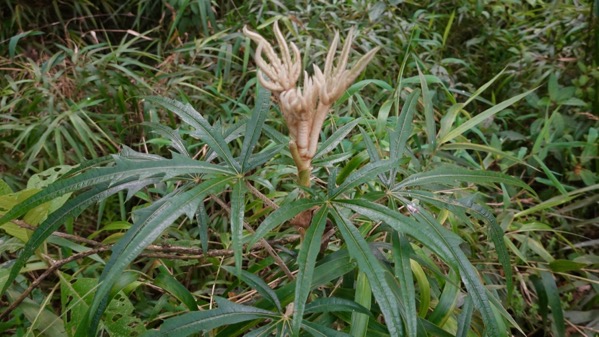
I had one of these, far less vigorous, in my freshman dorm room. I never got to see the new, beige leaflets.

Here is the downside of the path. It went up and up and up, to perhaps 9800 feet (from perhaps 9100 at the parking lot). We took it very slowly, and looked for plants, flowers, and creatures of interest.

I found a slug on a trail marker and heard a very few bird calls. I expected more….

Descending, we found a great valley view. Green green green.

The last feature before the parking lot was a fancy “pic-nic” area. We saw maybe nine of these.

We bumped along that miserable 5.3 km, then took a different route than we came through in the morning, to avoid Sangolquí, which I have nicknamed Traffic Jam Town. This is our turn off the highway to access the route to the hotel. As you can see.
This was a very different day than the previous ones we’ve spent here in the Ecuadorian valleys. Nice to have the diversity. This place is high-altitude for us, and today we really felt it. And survived.
Monday, 18 July 2022
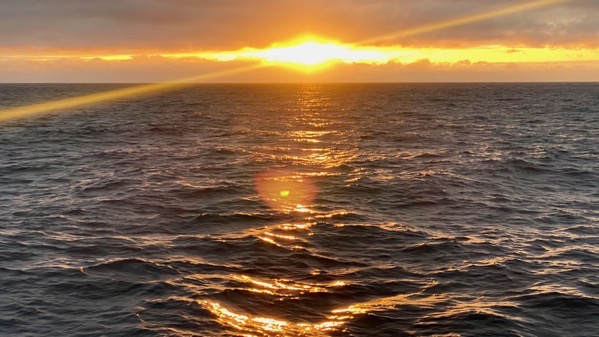
Another glorious sunrise.

Clockwise: husband coffee, wife coffee, husband batman oreos. Actual breakfast followed.

Commonly described as resembling a “Chinese coolie” hat, feast your eyes on Sombrero Chino, the destination of our immediately-after-breakfast walk. [When will this island be renamed for PC reasons?]

It began with a panga tour along a section of the lava-liscious coast, searching for wildlife.

Aha! Close view of a Galápagos hawk. Truly special to see it like this.

Wet landing, then part of the walk was on coral bits. This is the first time we’ve seen concentrations of coral like this.

Lava flow, cooled in place on its gravity-fed descent.

Water meets lava.

We spent some time watching the land iguanas emerging from this space between rocks where they had huddled together for warmth through the night (it was still early). They would stop almost immediately, perhaps doing internal iguana-yawns. Here are two adults and two young.
Back aboard we had lunch followed by our check-out briefing. Sad to contemplate the end of our fabulous excursion in the eastern Galápagos, the part with the older islands—older geologically, so more soil development in general, enabling more diverse plant life.
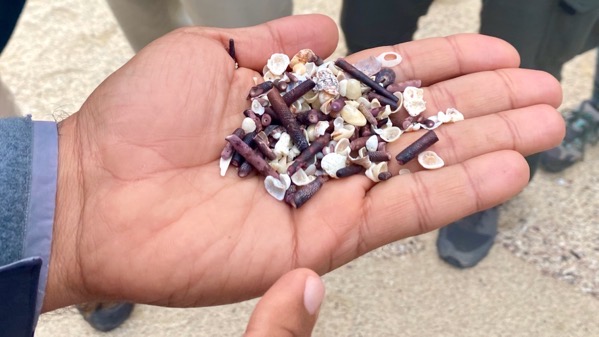
Afternoon dry landing on Cerro Dragón. This beach had teeny shells and sea urchin spines. Those are the fat tubes in Gustavo-the-Guide’s hand. He said his father and his contemporaries used those spine chunks on slate in school, and thus the common name is pencil sea urchin.

The tide was out a bit, exposing a sandy area with many hermit crabs, mostly not seen. They did leave evidence, not only their burrows, but also these sand balls. They take in the sand, filter all the organic matter that’s in it, then spit out the sand in these little balls.

Sleeping/resting dragon.
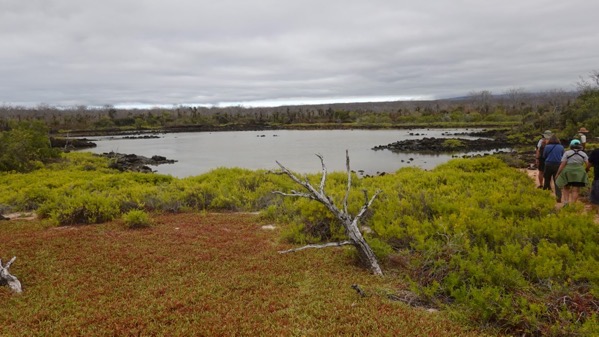
Brackish pond.

Stilt? Already forgot.

It took Gustavo’s sharp and well-trained eyes to spot this katydid, right by the trail.

Mature male land iguana. “Doing what they do best,” as Gustavo said.

Mature male iguana in “our” trail. Burrow nearby. Linear patterns in the sand are tail drag marks.

Finch.

View to sea.

Bartender Javier’s preparations are underway for the goodbye meet-up and toasts with the crew. Scarlett the Cruise Director once again went along the crew line-up, detailing their responsibilities and names. [This also helped us with tipping before we disembarked.] Several of us short-timers made a little speech of thanks. I did one in Spanish on behalf of all of us; my Spanish, although still stilted, has come back relatively rapidly after, what?, perhaps twenty-five years of disuse. Good for my brain.

Best tomato soup I’ve ever had. I am not a Campbell’s fan. This has no cream, and includes potatoes. The crew kindly used Google translate to make and print a recipe for several interested guests. The first ingredient was a certain amount of “dad.” Someone among us was clever enough to realize this was a translation of “papa.” While, of course, not an incorrect translation, it was the wrong one here. Papa means papa/dad, the Pope (as in Father), as well as potatoes.
Sunday, 17 July 2022

We traveled overnight, and boarded pangas starting at 6am to walk on North Seymour Island. The park regulations say that no one can be on land between 8pm and 8am. They require overnight ship passengers are only on land until 10am and after 3pm. The day-trippers get the hot, bright hours in between when many of the animals are far less active. I checked and this photo was at 6:07am, just after we started walking. Pretty sure these are frigate birds.

Sofia is discussing rat problems. The trap has low-level sulfur in it, enough to kill the rat after a time, and not enough that a hawk will sicken from eating it. Rats are of course introduced, and a problem along with goats, dogs, cats, and at least one insect, all causing significant problems.
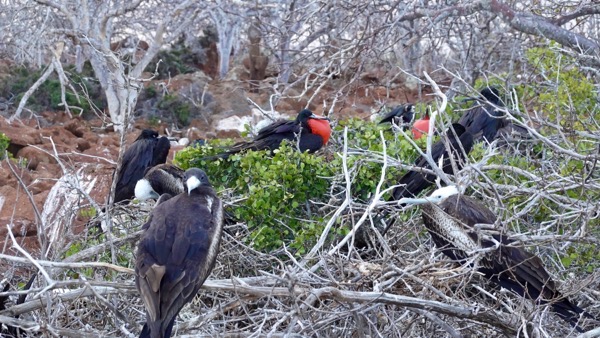
Call this a frigate bird condo. Frigate birds don’t need much personal space, as you can tell, so the gents try to build their nests in the best trees, to catch a lady frigate bird. The red sacs take perhaps twenty minutes to inflate or deflate. They attract lady frigates to check out nest quality. If the latter meets spec, they will stay and mate.

Frigates pairing up.

Beautiful morning rainbow omen.

If I have it right, the Galápagos islands were stripped of this lichen at one time, to sell for making a purple dye. Lichens are of course slow-growing, so it has taken many decades for them to return.

Land iguana.

Posing bird. I’m anthropomorphizing.

See the two islands? Those are the Daphnes, with Daphne Major to the left, and Daphne Minor to the right. The famous forty-year study of finches by the Grants was on Daphne Major. Others have continued studies. Check out “The Beak of the Finch: A Story of Evolution in Our Time” by Jonathan Weiner if you’re interested.
On land you can see pairs of white stakes. We only walk between them.

When the booby parent comes back from fishing, the booby baby (technical naturalist term), bangs beaks with the parent. This eventually stimulates the parental bird to regurgitate. The chick sticks its head down the parental throat to get the food.
Aren’t you glad this isn’t the human style.
Back aboard, the Grace got underway and we had breakfast, then most of us watched two very well-made videos, one on Darwin and Wallace, and one on von Humboldt. The latter was a contemporary of Thomas Jefferson, and probably the first person you could consider a modern naturalist, at least in the Western world. I’m going to hunt up a copy of Wulf’s “The Invention of Nature: Alexander von Humboldt’s New World” to read up on this fascinating man and how he laid the groundwork for his successors.
Next, we had a lovely snorkel followed by a late lunch, if I have it right. Or perhaps the snorkel was after lunch? I forgot to record some details.

Our late-day panga trip located, tada!, penguins. The only tropical penguins. Soooo wonderful.

This is a dry landing on Bartolomé. Many other ships in this area.

Bartolomé has a boardwalk, only it’s mostly steps. It goes to the top. We made many photos in the late-day sun.

Note the many cinder cones. Sooooo different from every other island we’ve visited.
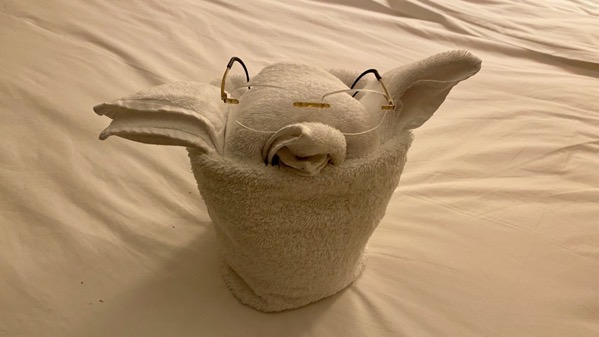
When we return after our afternoon excursions, we are greeted by a critter. I think this is a towel owl, a short-eared owl, yet, oddly wearing (my) spectacles. Teehee. John says its a baby Yoda.
Saturday, 16 July 2022
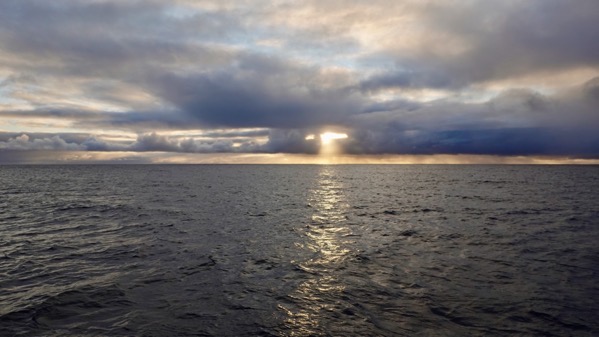
There’s no such thing as too many beautiful sunrises.
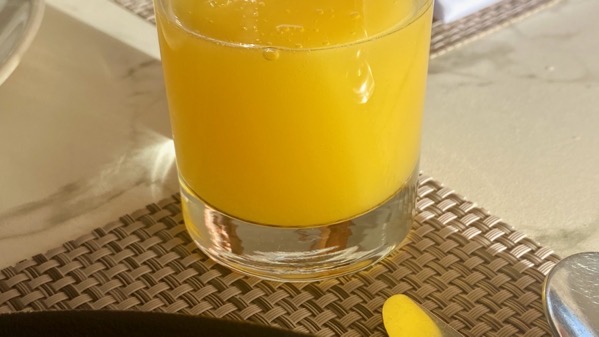
Juice every morning, and every morning a different fruit. This may be what everyone called tree tomato. I just checked the internet, and in New Zealand it’s called tamarillo. It’s in the Solanaceae family, and is Solanum betaceum. Now I know.
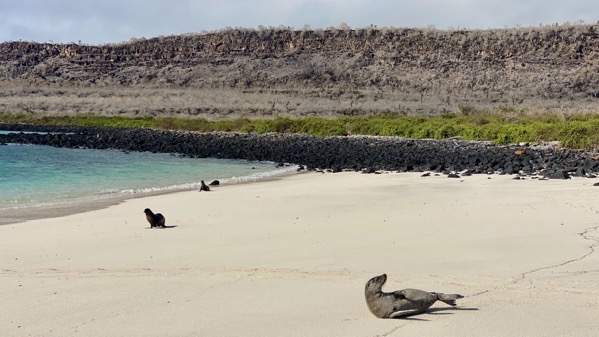
Right after breakfast, we had a wet landing on Santa Fe Island. The sea lions were just becoming active.

This was a short walk to see these giant-size opuntias. The pads are not tasty to humans, but are the favorite of land iguanas.
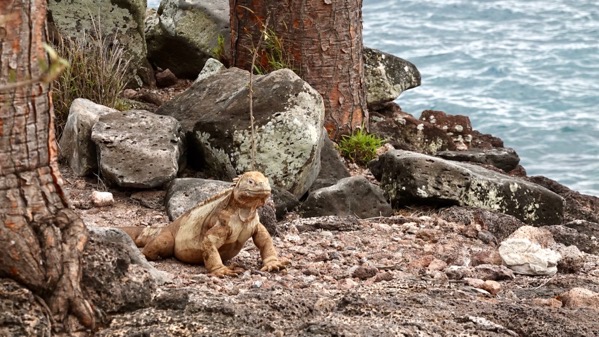
Right on schedule, here’s a large male land iguana.
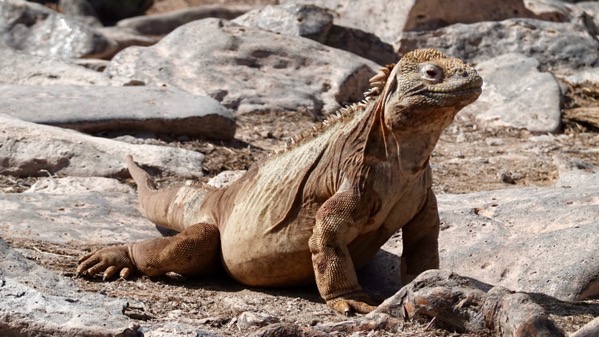
And another.
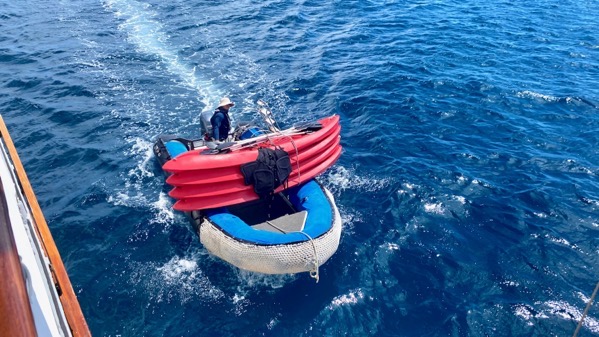
Back on the Grace, the crew lowered kayaks and the pangas took us to a good kayaking spot.
After that, we changed into wet suits for a snorkeling expedition. Again, no photos of these two activities. Salt water, you know.

After lunch, I spotted this hitchhiker. Another came and ousted it.

Dry landing on South Plaza island, and a slow 90-minute loop. Nocturnal gull.
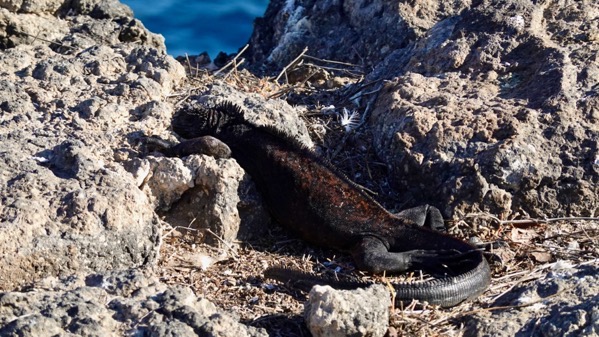
Marine iguana. Note longer narrow tail, used as a paddle in the water. Also, the land iguana’s tails are more rounded on the bottom, a good tip if you find their tracks.
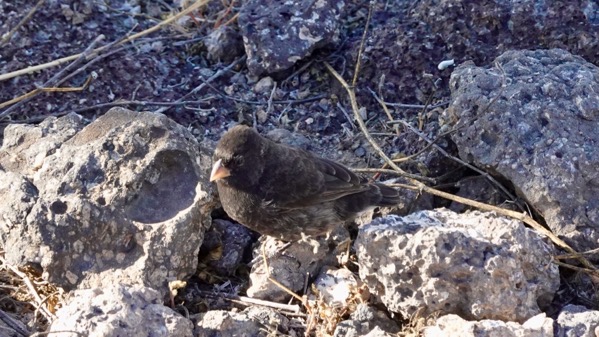
A finch busy looking for…seeds, I think.

Little lava lizard…little compared to the iguanas. On the “trunk” of one of the tall opuntias.
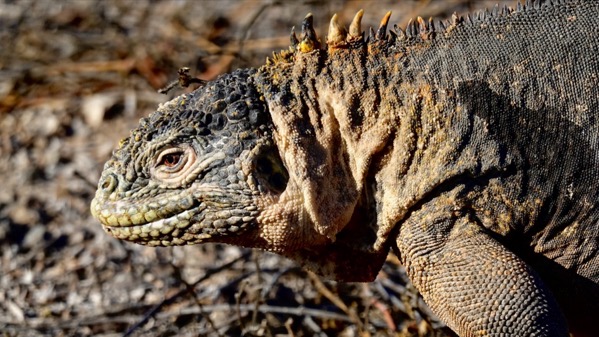
Land iguana profile. Those neck spikes draw my eye every time.
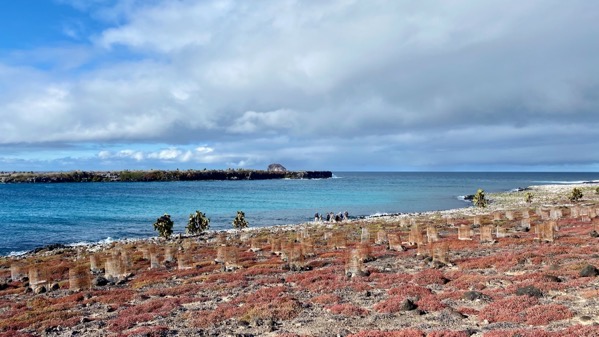
The iguanas have so aggressively dined on the opuntias on the west end of South Plaza that the park folk have planted new ones, with these protective cages. Still, they have had to replant and replant, as the small opuntias are easier for the iguanas to climb and access the pads, as you might guess. Even with the protective cages.

Sun is cruising down, although it’s still an hour and a half to sunset.
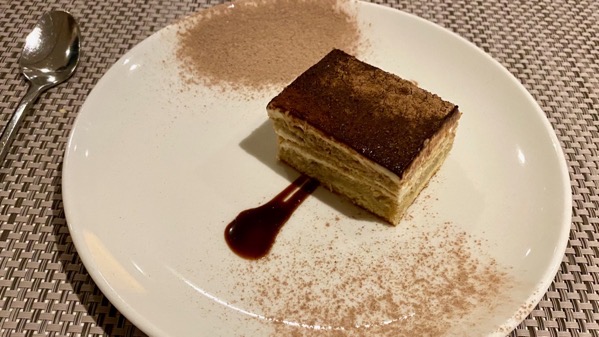
Sous Chef Washington’s tiramisu was a resounding success. Several of us thought it the best we’d ever had.
Did you catch that we did a walk, a kayak ride, and a snorkeling expedition all before lunch? I have never changed my clothing so many times day after day in my life.
Friday, 15 July 2022

Too overcast for a dawn photo, so here’s the coffee, tea, and water station. That’s an urn of fine organic Ecuadoran coffee on the right, with a Euro coffee machine that makes latte machiatos, cappuccinos, and the like. Cold and hot water to the far right.

First off-ship activity: land on that beach to the left, walk into the interior, turn to the left and walk to cliffs on the other side, return.
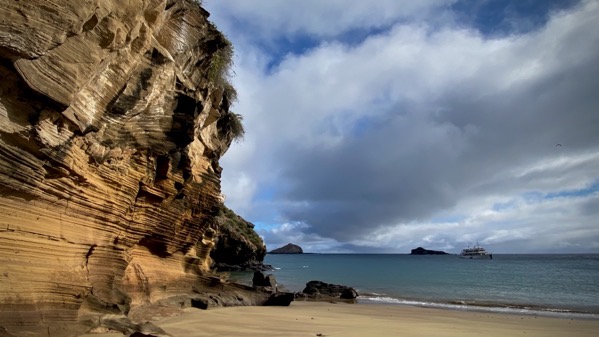
This is the rock on the “right” end of the beach. Looks like funky sandstone, right? It’s compressed volcanic ash deposits from many different eruptions, if I have it right.
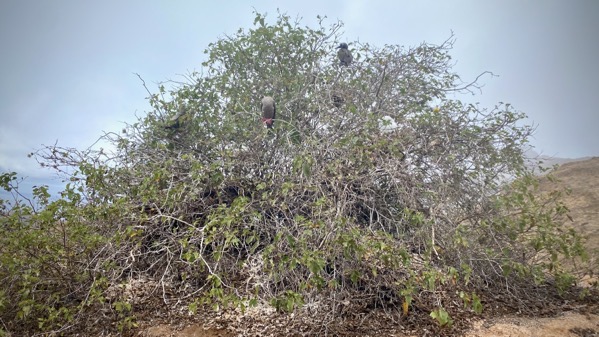
Red-footed booby condo. At least five families/nests here. Males build a nest then advertize it to the lady-birds. Location and nest quality are everything to the ladies, in that order. This is a safe tree in an excellent location.
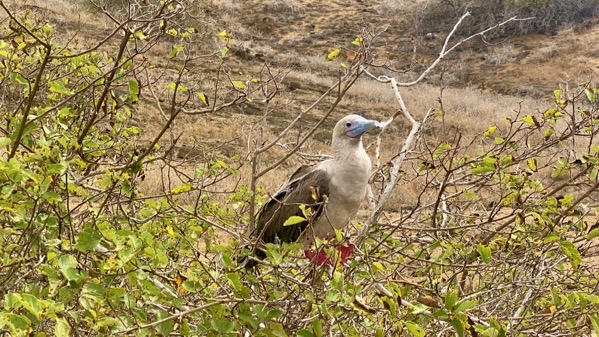
Very red, those feet. Beak is a light blue.

Endemic locust.

Eastern-most point on Galápagos archipelago: Punta Pitt.
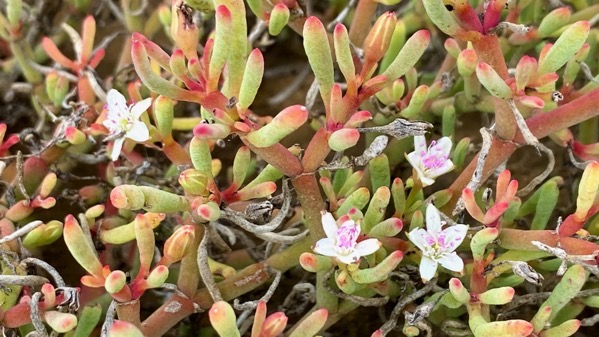
Blooming succulent, possibly common carpet weed.
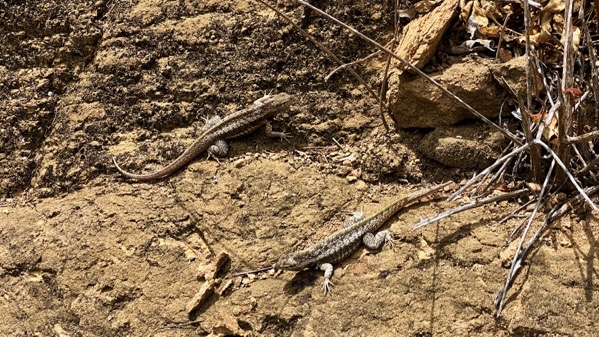
Fighting male lava lizards. This is not territorial, it’s just to fight. They run in a circle, then use their tails to thwack the other guy. The male on the left has an advantage in this, as he has all his tail, and the opponent has a shortened tail.
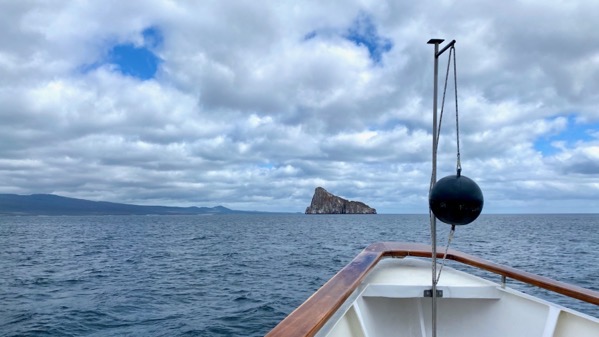
This is Kicker Rock. It’s darned famous. Our captain circled it. Since it was mid-afternoon there were only a few birds, but several hours later, many would return from fishing expeditions, we were told.

Kicker Rock is actually two rocks. Those slabs of white on the sides: guano. Not mineralization or geologic formation. Next, we did a snorkeling expedition from the pangas. Lots of fish species and many sea lions. Very large sea urchin sand dollars. Fabulous snorkeling.

Pelican. Isla Lobos.

Candelabra cactus, with ever-present guano-ed rocks.
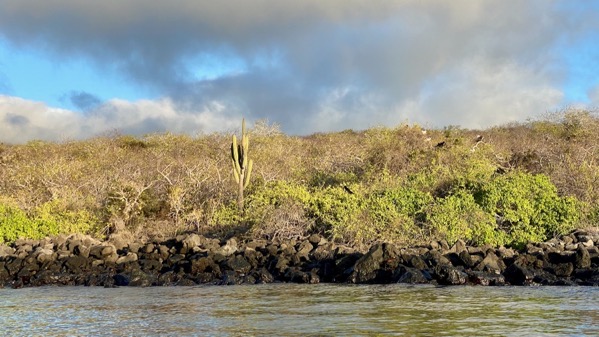
San Cristóbal vegetation.
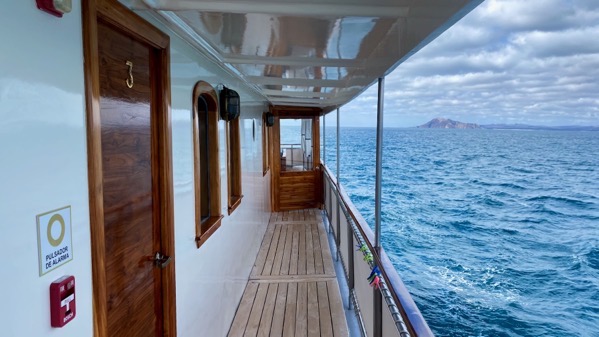
Our cabin door and two windows, view toward stern.

Almost sunset. Remember this is the equator. Year-round, sunrise and sunset are at 6 am and 6 pm, or pretty darned close. No change. And the light changes fast.
Thursday, 30 June 2022

How is it we are almost half way through 2022? It seems like the year began so very recently.
Last night after dark we had a power hit for about two hours. We heard the pop that I associate with a whoz-it blowing right before the power went. Data. Predictability.
Monday, 27 June 2022

When it began, the rain was tentative. Then, it picked up strength, for a real wetting of our weedy front beds. You can guess what is on my to-do list for early tomorrow morning’s cool.
Sunday, 26 June 2022

That Friday ruling took the pizzazz out of my weekend. Well, truthfully, far more than pizzazz.
Still thinking that those who believe in proselytizing are therefore arrogant (as in: I know better than you), and have no business being judges. I’ll leave it there…as steam rolls out of my ears.
Friday, 24 June 2022
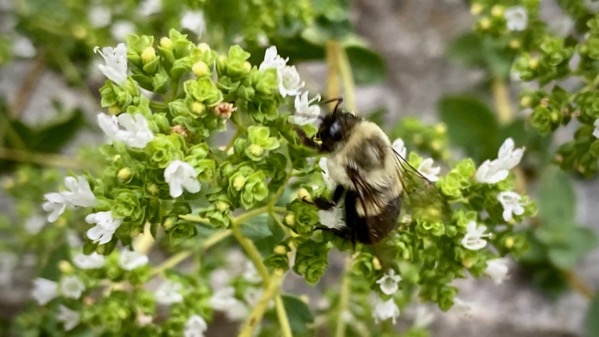
I’m glad the bees are getting goodie from this oregano, because I keep forgetting to use it in the kitchen. Hmm; perhaps some chili next week, with sprigs of oregano!